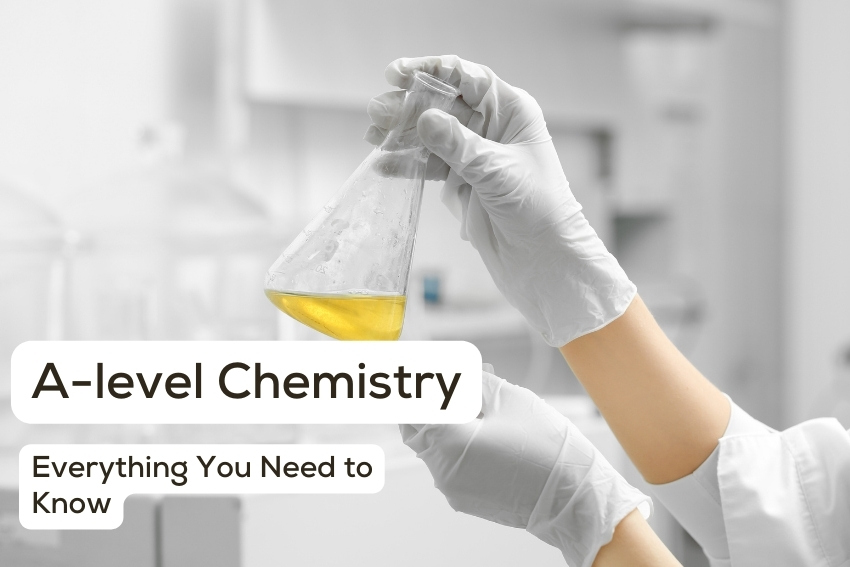Chemistry, often referred to as the ‘central science,’ is pivotal in shaping the modern world, from medicine and healthcare to energy and the environment. A-level Chemistry, therefore, serves as an important educational milestone, providing the foundational knowledge and skills needed for a multitude of scientific disciplines and careers. This article aims to provide an in-depth guide to navigating the complexities of A-level Chemistry, from understanding its grading system to exploring its key topics, common challenges, and beyond. Whether one is looking to bolster their academic understanding or seeking guidance on the best resources for effective revision, this guide aims to offer valuable insights into the A-level Chemistry landscape.
Understanding A-levels
A Brief History
A-levels were introduced in the UK in the 1950s as a standardised set of examinations intended to bridge the gap between secondary education and university. Over the decades, they have undergone numerous reforms but have retained their central role in the UK’s educational system.
The Role of A-levels
A-levels are typically taken over a two-year period, usually by students aged 16 to 18, and are one of the main routes into higher education. They serve as a rite of passage for those aiming to attend university and often determine eligibility for specific courses. A student’s choice of A-level subjects can be both a reflection of their academic interests and a crucial factor in their future career path.
Subject Selection
The number of subjects a student chooses can vary but is usually between three and four. These subjects can range from traditional academic subjects like Mathematics, English, and the Sciences, to more vocational options such as Business Studies or Media Studies. The choice often depends on university course requirements, career aspirations, or personal interests.
Modular vs. Linear A-levels
In the past, A-levels were modular, meaning that assessments took place at various points throughout the course. However, most A-levels have now shifted to a linear structure, where all examinations are taken at the end of the course. This change aims to provide a more holistic understanding of the subject matter, as opposed to fragmenting it into smaller modules.
By revisiting what is already known and exploring these additional facets, the complexities and the pivotal role that A-levels play in shaping educational and career trajectories can be better appreciated.
Deciphering the A-level Grading Scheme
Navigating the grading scheme for A-levels can initially seem like a daunting task, especially when considering its importance in university admissions and future career opportunities. Here’s a breakdown to simplify this critical aspect of A-levels.
Grading System
At the A-level, grades range from the highest, A*, down to E as the minimum level of pass, with U (Ungraded/Unclassified) indicating a fail. The grades typically correspond to a range of marks, which are set by examination boards.
- A*: 90-100%
- A: 80-89%
- B: 70-79%
- C: 60-69%
- D: 50-59%
- E: 40-49%
- U: Below 40%
UCAS Points
Understanding UCAS (Universities and Colleges Admissions Service) points is essential, especially for those considering university education. Each A-level grade carries a specific UCAS tariff point, which universities use as one of their admission criteria. For example, an A* might equate to 56 UCAS points, an A to 48 points, and so on.
Conditional Offers
Many universities make conditional offers, meaning that an applicant will be accepted if they achieve specific A-level grades. These conditions often reflect the competitiveness and prerequisites of the chosen course.
Resits and Remark Requests
If a student is unsatisfied with their grade, they have options such as requesting a remark or taking a resit. Both options come with their own set of rules and deadlines, dictated by the respective examination boards.
Implications for University and Beyond
While A-level grades are pivotal for university admissions, they can also have long-term impacts. Some employers, particularly in sectors like Law and Finance, may consider A-level grades when hiring, even several years after an individual has graduated from university.
By understanding the grading scheme, its associated UCAS points, and the broader implications, one gains a clearer picture of how A-level performance can shape future educational and career paths.
Essential Topics in A-level Chemistry

Chemistry is often dubbed the ‘central science’ as it connects and overlaps with multiple scientific disciplines. The A-level Chemistry syllabus is designed to offer a broad and deep understanding of the subject. Below are some of the key topics that make up the A-level Chemistry curriculum.
Organic Chemistry
Organic chemistry explores the structure, properties, and reactions of carbon-containing compounds. It encompasses topics such as:
- Alkanes and Alkenes
- Isomerism
- Aromatic Compounds
- Organic Synthesis
Organic chemistry is crucial for understanding biological systems and is highly relevant in pharmaceuticals, petrochemicals, and agriculture.
Inorganic Chemistry
Inorganic chemistry deals with the properties and behaviour of inorganic compounds, which do not contain carbon-hydrogen (C-H) bonds. Key areas include:
- Periodicity
- Transition Metals
- Coordination Compounds
- Redox Reactions
This branch is important in materials science, catalysis, and environmental science.
Physical Chemistry
Physical chemistry bridges the gap between the macroscopic world and molecular behaviour. It includes:
- Thermodynamics
- Kinetics
- Equilibrium
- Electrochemistry
These principles are fundamental to all areas of chemistry and are also applicable in physics and engineering.
Practical Skills in Chemistry
Practical skills are an integral part of A-level Chemistry and are assessed both in the laboratory and through written examinations. Topics might include:
- Titration Techniques
- Spectroscopy
- Chromatography
- Data Analysis
These skills are not just exam requirements but are essential for anyone considering a scientific career.
Real-World Applications
Each of these topics has real-world implications and applications. For instance:
- Organic chemistry is vital in drug discovery and biotechnology.
- Inorganic chemistry plays a role in renewable energy technologies.
- Physical chemistry helps in understanding processes like corrosion and catalysis.
Understanding these essential topics in A-level Chemistry offers not only academic enrichment but also a glimpse into the relevance and impact of chemistry in everyday life and various professional fields.
Common Challenges in A-level Chemistry
Navigating the intricacies of A-level Chemistry can be a daunting task. While the subject is undeniably fascinating, it comes with its own set of challenges that may pose difficulties for those who are studying it. Understanding these challenges can provide valuable insights into how to better prepare for the subject.
Complexity of Topics
Chemistry is a multifaceted discipline that delves into the microscopic details of matter and its interactions. Topics like organic synthesis or electrochemistry can be particularly challenging due to their complexity and the level of understanding they require.
Mathematical Skills
Chemistry is not just about understanding concepts; it also involves applying mathematical principles. Topics such as thermodynamics and kinetics require a strong mathematical foundation, often causing difficulties for those who may not be as confident in maths.
Balancing Theory and Practical Work
A-level Chemistry includes both theoretical and practical components. The challenge often lies in balancing the two. While understanding the theoretical principles is crucial, mastering the laboratory techniques is equally important. This duality can sometimes be overwhelming.
Time Management
The breadth and depth of the A-level Chemistry syllabus require a significant time commitment. Proper time management becomes a challenge, especially when juggling other A-level subjects and extracurricular activities.
Conceptual Understanding vs. Rote Learning
Chemistry requires both conceptual understanding and memorisation. Students often struggle with striking a balance between understanding the fundamental principles and memorising the myriad facts, formulas, and reactions necessary for exams.
Exam Technique
Finally, the way questions are phrased in exams can be a hurdle. Understanding what is being asked and how to structure answers appropriately is an essential skill that can often be overlooked.
Being aware of these common challenges provides not just a clearer understanding of what to expect but also offers an opportunity to devise strategies for effective study and exam preparation.
A Close Look at Sample A-level Chemistry Exam Questions
Exam questions in A-level Chemistry can often be the stumbling block where theory meets practice. Understanding how to approach these questions and the common mistakes to avoid can be invaluable. Below are some sample questions along with in-depth explanations that shed light on typical errors and how to navigate them.
Question 1: Calculating Moles from Mass
Sample Question:
Calculate the number of moles of sodium chloride in 58.5g. (Molar mass of NaCl = 58.5 g/mol)
Common Mistake:
Some students might directly use the mass of the substance without considering its molar mass.
Correct Approach:
To find the number of moles, the formula is:
Number of moles=Mass/Molar mass
By applying this formula, one avoids the mistake of not taking the molar mass into account.
Question 2: Acid-Base Titration
Sample Question:
Why is phenolphthalein a suitable indicator for a titration between hydrochloric acid and sodium hydroxide?
Common Mistake:
Students often give vague answers like, “It changes colour.”
Correct Approach:
The ideal answer should explain that phenolphthalein changes colour within the pH range where the equivalence point is expected to occur for the reaction between hydrochloric acid and sodium hydroxide.
Question 3: Organic Synthesis
Sample Question:
Outline the steps to synthesise ethyl ethanoate from ethanol and ethanoic acid.
Common Mistake:
Some students miss out on mentioning the catalyst or the conditions required for the reaction.
Correct Approach:
The answer should include the reactants, the catalyst (usually concentrated sulfuric acid), and the reaction conditions, such as refluxing the mixture.
Question 4: Periodicity
Sample Question:
Explain why the atomic radius decreases across a period.
Common Mistake:
Students may mistakenly attribute this to an increase in the number of shells.
Correct Approach:
The correct answer should mention that the atomic radius decreases due to increased nuclear charge pulling electrons closer to the nucleus, without the addition of new electron shells.
By dissecting these sample questions and understanding the common mistakes that can be made, one gains an edge in tackling the complexities of A-level Chemistry exam questions.
The A-level Chemistry Marking Scheme and Its Objectives
Understanding the marking scheme of A-level Chemistry is pivotal for effective exam preparation. Not only does it provide a roadmap for how marks are distributed, but it also reveals the objectives that examiners have in mind when assessing performance.
Distribution of Marks
In A-level Chemistry, marks are typically distributed among various components, including:
- Multiple-Choice Questions
- Short Answer Questions
- Calculations
- Extended Responses
- Practical Assessments
Each component has its own weightage, which varies depending on the examination board. For example, multiple-choice questions might constitute 20% of the total marks, whereas extended responses could make up 30%.
Assessment of Practical Skills

Practical skills are an integral part of the A-level Chemistry curriculum. These skills are assessed both through written exams and separate practical endorsements. The aim is to ensure that students are competent in key laboratory techniques and can apply theoretical knowledge in a practical setting.
Objectives Behind Marking
The marking scheme is designed to assess a range of skills and understanding:
- Knowledge and Understanding: Grasping the key concepts and principles of chemistry.
- Application: Applying this knowledge to new and unfamiliar situations.
- Analysis: Interpreting data and solving problems, often requiring mathematical skills.
- Evaluation: Making judgments based on evidence, such as evaluating experimental methods or explaining limitations.
Levels of Response
For extended response questions, examiners often use ‘Levels of Response’ marking. In this approach, marks are awarded not just for the content but also for the quality of written communication. This includes clarity, logical flow, and the effective use of technical terms.
Importance of Past Papers
One of the most effective ways to familiarise oneself with the marking scheme is through the use of past papers. These provide invaluable insights into the types of questions asked, how marks are allocated, and what examiners are looking for in high-quality answers.
By gaining a comprehensive understanding of the A-level Chemistry marking scheme and its objectives, one is better equipped to align their study strategies and exam techniques to meet these criteria effectively.
Recommended Revision Resources for A-level Chemistry
Preparing for A-level Chemistry requires a variety of resources to build a robust understanding of the subject. From textbooks to online platforms, each resource offers unique benefits that can aid in effective revision. Below is a list of recommended resources that cater to different learning styles and needs.
Textbooks
- A-Level Chemistry for OCR A: Comprehensive and tailored to the OCR syllabus.
- Edexcel A level Chemistry Student Book: Specifically designed for the Edexcel exam board.
- Chemistry in Context: A general textbook that places chemistry in real-world scenarios.
Textbooks offer structured learning and often include sample questions, explanations, and summaries that are aligned with the exam board’s syllabus.
Online Platforms
- Chemguide: Offers free explanations of various chemistry topics.
- Khan Academy: Provides video lectures and exercises.
- Physics & Maths Tutor: Includes past papers, revision notes, and quizzes.
Online platforms offer the flexibility of studying at one’s own pace and often provide interactive ways to grasp complex topics.
Apps
- The PocketLab: A virtual lab experience.
- Brainscape’s A-Level Chemistry Flashcards: For quick revision and memorisation.
- ChemCollective Virtual Labs: Allows students to perform virtual chemistry experiments.
Apps offer portable and interactive learning experiences, making it easier to study on the go.
YouTube Channels
- Tyler DeWitt: Breaks down complex topics into easily understandable explanations.
- MaChemGuy: Focuses on A-level specific topics and provides exam tips.
YouTube channels offer visual and auditory learners an alternative method to grasp difficult concepts.
Study Groups and Forums
- Reddit’s r/6thForm: A place to discuss A-level topics and seek advice.
- The Student Room: Offers forums where you can ask questions and share resources.
Study groups and forums allow for collaborative learning and offer a platform to seek help on challenging topics.
Utilising a combination of these resources can offer a well-rounded approach to A-level Chemistry revision, catering to various learning needs and preferences.
Conclusion
Navigating the world of A-level Chemistry is akin to embarking on a scientific expedition. It’s a journey that takes us deep into the fabric of matter, helps us understand the building blocks of life, and arms us with the knowledge to solve some of the world’s most pressing challenges—from healthcare to sustainable energy. Yet, the path is strewn with complexities that require not just hard work but also the right guidance and resources.
In this age of information, there’s no shortage of study material, but the challenge often lies in sifting through the noise to find the signal. While textbooks, online resources, and past papers are invaluable, nothing quite replaces the personalised guidance that can adapt to individual learning needs and styles. That’s where Edumentors comes into play.
What sets Edumentors apart is its roster of tutors—all students from top UK universities—who bring not just academic excellence but also a fresh, relatable perspective to the table. They understand the rigours and nuances of A-level Chemistry because they’ve been through it themselves. They’re not just tutors; they’re mentors who are committed to helping students not only reach their academic goals but also bolster their confidence.
A-level Chemistry is more than just an exam or a stepping stone to university. It’s an intellectual investment that pays dividends in myriad ways, enriching one’s worldview and opening doors to diverse career paths. So, for those who are committed to mastering this enriching subject and are looking for that extra edge, consider partnering with Edumentors. Because when it comes to shaping futures, every molecule of effort counts.
Now, as you close this guide and contemplate the journey ahead, remember that the elixir of success in A-level Chemistry—and indeed, in life—is a blend of curiosity, preparation, and the right mentorship. So, equip yourself wisely and set forth on this fascinating voyage of discovery. After all, in the words of Marie Curie, “Now is the time to understand more, so that we may fear less.”









